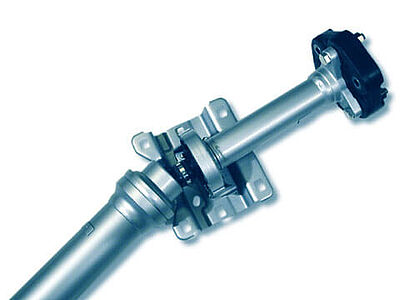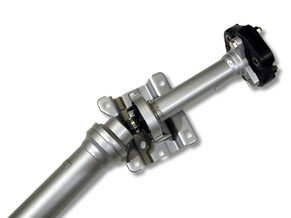Longitudinal shaft

The longitudinal shaft or cardan shaft is a very important component for rear-wheel drive and all-wheel drive. Its task is to transmit the torque from the engine/gearbox unit to the axle differential...
Function
 The longitudinal shaft or cardan shaft is a very important component for rear-wheel drive and all-wheel drive.
The longitudinal shaft or cardan shaft is a very important component for rear-wheel drive and all-wheel drive.
Its task is to transmit the torque from the engine/gearbox unit to the axle differential. In some cases, long distances have to be bridged between the units. Therefore, longitudinal shafts can have not just one but two or three sections.
Types of longitudinal shafts
Longitudinal shafts can be manufactured from aluminium, fibre composites or steel. Universal joints (or cardan joints, as they are also known), flexible couplings or high-sped constant velocity joints provide the requisite connections. Strictly speaking, cardan joints are not constant velocity joints. As such they can only be used in applications with low bending angles.
Depending on the vehicle model, automotive manufacturers use single-section, two-section or three-section longitudinal shafts with different options for intermediate bearings, sliders, impact optimisation, vibration damping and adjusting capacity.
Here are some examples:
- Single-section front longitudinal shafts are usually used for all
- wheel drive vehicles (light commercial vehicles and SUVs in particular); they transmit the torque from the transfer box to the front axle differential.
- Two-section shafts are the most frequent configuration for vehicles with rear-wheel or all-wheel drive. The longitudinal shaft is supported by an intermediate bearing in the centre. With regard to their longitudinal and angular variability and their vibrational and noise characteristics, the three joints used in this shaft are matched specifically to the vehicle and its crash performance.
- Three-section longitudinal shafts are increasingly being used in vehicles with rear-wheel and all-wheel drive, where outstanding vibrational and noise characteristics are required and the longitudinal shaft must fit into a complex vehicle underbody. Three-section shafts have two intermediate bearings attaching them to the vehicle floor and four high-speed joints.
Due to the relative movements between the axles and the gearbox and high shock loads when driving off-road, the shaft joints and couplings must be able to withstand high levels of stress. Dividing the longitudinal shaft increases bending stiffness and thus rigidity at high speeds.
Depreciation
To maximise service life and minimise levels of noise and vibration, they must be highly rigid and stiff as well as precisely balanced and light. Therefore, the steel tubes of longitudinal shafts have long since increasingly been replaced with aluminium tubes. As they are lighter in weight, shafts made from aluminium also exhibit fewer problems with unbalance.
Single-section longitudinal shafts are still being installed in vehicles with short wheelbase. However, today, most shafts features two or three sections. Constant velocity joints are increasingly being used on account of the relatively high bending angle. Durable sealing systems which protect the joints throughout their service lives have been developed for all of these products.
Longitudinal shafts are maintenance-free. They are designed to last the entire service life of the vehicle. Bearings, joints and shafts are checked for damage and premature wear during the service inspections at the intervals prescribed by the manufacturer.
Safety
As it has a significant effect on how the vehicle responds in the event of a crash, the design and build of the longitudinal shaft is usually vehicle-specific. The crash-optimised longitudinal shaft is a genuine innovation in vehicle safety engineering. It is characterised by the predictable and progressive way in which it breaks up in the event of a collision. It reduces not only the risk of injury for the vehicle occupants but also the danger of important safety systems being taken out of service in the event of a collision.
Any combination is possible: from low load absorption at low impact energy to high load absorption at high impact energy. In terms of design and build this is solved with crash-optimised constant velocity joints, inversion tubes, longitudinal toothing and telescopic tubes.
All of these solutions contribute to increasing safety and making driving more enjoyable.
Environmental protection
Lightness of weight is a key consideration in the design and build of modern longitudinal shafts, because by reducing the weight of individual components the overall weight of a vehicle can be reduced. As a result, fuel consumption goes down. For example, single-section rear longitudinal shafts are particularly light in weight, as they are made from aluminium. Combinations of different materials in a single shaft are also possible.
Composite materials with adjustable torsional and bending properties provide another means of reducing weight.
Downloads
Here you can find all available downloads for the topic "Longitudinal shaft":
All file downloads:
